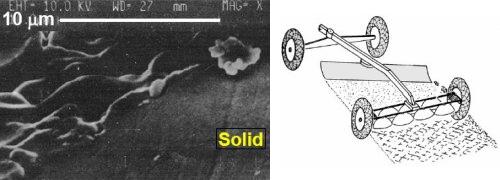A NASA scientist suggests extracting material from lunar dust to build roads, building blocks, and even extract iron from it for the use of a future human colony

By: Avi Blizovsky
"If you can't beat them, join them." It's a cliché that means you'll find a solution to living with everything you can't get rid of. This could be great advice for those who intend to live and work on the moon.
Scientists and engineers who have figured out how to return the astronauts to the moon, build a living environment and a mine from the lunar soil to produce everything from building materials to rocket fuel, are scratching their heads and wondering what to do with the moon dust. This dust is everywhere! The powdery sand sticks to everything, clogs the openings of the spacecraft and causes friction in the space suit. This sand easily accumulates an electrostatic charge, floats over the surface of the moon and sticks to the camera lens and front of the plate, and it may even be toxic.
So what do we do with all the annoying dust? Larry Taylor Distinguished Professor of Planetary Sciences at the University of Tennessee has an idea: don't try to get rid of it - melt it into something useful!
"I'm one of those weird people who likes to shove things into a regular microwave and see what happens," Taylor confessed to hundreds of scientists at the LEAG (Lunar exploration advisory group) meeting at the Johnson Space Center last month.
At his home in Tennessee, his famous experiment involves a bar of Irish Spring soap that quickly turns into a monstrous monster when the microwave's power button is pressed. But that's not what he talked about at the gathering.
And by the way of the moon, he once microwaved a small piece of lunar sand brought by the astronauts from Apollo. He found that this sand melts at lightning speed in 30 seconds, even at a low power of 250 watts.
The reason for this is in the composition of the lunar regolith. This material is formed when small meteorites crash into the surface of the Moon at a speed of 10 kilometers per second. From the heat generated in this crash, the material melts and turns into a kind of glass grains. The glass contains a tiny amount - about a millimicron of pure iron called nanophase iron. It is the tiny particle that effectively concentrates the microwave energy that sticks (bonding material particles together by heating but not melting) or unites the free dirt into a large group.
The discovery encouraged Taylor to imagine building mini-machines to send to the moon that could melt the lunar dust and turn this iron into efficient and useful solid iron.
"Imagine a carriage towed behind a lunar vehicle, equipped with an equipment system that contains magnets and executes the same patent according to which the microwave device operates from the inside. With the right power and microwave frequency, the astronaut can glue the sand as he walks, dig furrows half a meter deep, and then change the operation of the device so that it melts 4-5 centimeters and paves a glass path," he suggests.
"Or let's say you want to build a radio telescope," he continues, "find a rounded crater, and run a microwave mower up and down the sides of the crater to glue a smooth surface. Add an antenna from the center and you have a lunar Arecibo without much effort. He obviously refers to the huge radio telescope that has a diameter of 305 meters in Puerto Rico and which was built in a circular natural valley.
But technical challenges still remain. The changes that take place in the microwave when moon dust is applied to the Earth are not similar to the process that takes place on the airless moon. Researchers still need to work out the details of the process to produce a strong, uniformly bonded material in the harsh lunar environment.
But the idea is promising: gluing stones for building roads and producing bricks and radiation shields - and all this in a beneficial process that helps reduce the amount of dust is like killing two birds with one stone. "The only limit", says Taylor, "is the imagination".
